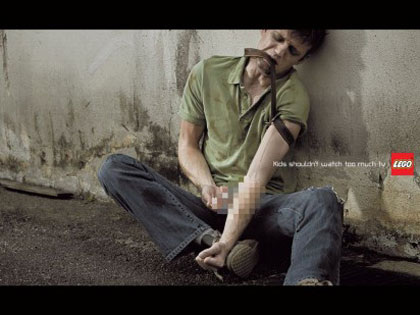In view of this, Lego developed a series of advertisements, suggesting Lego blocks could help to keep children away from the television and provide a good alternative for them to have fun. The images of the three advertisements were taken from scenes of TV programmes about drugs, sex or violence. The one selected for analysis is about taking drugs.
In the image, there was a man with dirty clothes sitting on the ground. He looked tired or sick as his hair was messy and he had big dark circles around his eyes. He was confused as he was frowning. These also made him looked like a poor guy or a bad guy. He tied a belt tight on his left arm. He was also holding something in his right hand but it was censored and cannot be seen.
Although an important part of the image could not be seen clearly, it is easy for an adult to recognize that the guy was taking drugs. It is a stereotype that a drug addict would look like the man in the advertisement. This made it a controversial advertisement. Although Lego aimed to target the advertisement to the parents, it was still a toy company which manufactures toys for children. Therefore, it is expected that the company would have a positive image, so that is could produce fun and healthy toys. However, the advertising campaign was too aggressive. The TV scenes chosen were too violent or unhealthy for kids. If the kids saw those images, they might be negatively influenced. So, it would also build a negative image of Lego in the parents’ minds, as the company did not consider the influences to children before developing the campaign.

 RSS Feed
RSS Feed